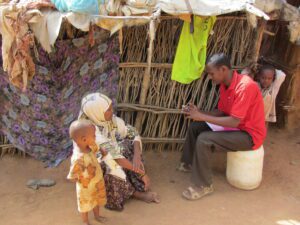Introduction
Curious about how to conduct a Successful Endline Survey in Uganda? Endline surveys are like snapshots taken at the end of a journey—they help us understand the impact of projects and interventions. In Uganda, where every initiative aims to uplift communities, these surveys play a crucial role in measuring progress and refining strategies.
This guide is your roadmap to mastering the art of Successful Endline Surveys in Uganda. Whether you’re evaluating a health program in Kampala or an education project in rural areas, knowing how to effectively conduct these surveys can make all the difference. Let’s dive in and uncover the essentials together.
Understanding Successful Endline Surveys in Uganda
Wondering what a successful endline survey in Uganda really entails? Let’s break it down:
How Do Endline Surveys Work?
Endline surveys are evaluations carried out to gauge the success of a project at its end. These surveys are essential for determining how well projects in Uganda have accomplished their objectives.
Important Distinctions from Baseline Surveys
Endline surveys concentrate on assessing the results and efficacy of interventions over time, in contrast to baseline surveys, which are carried out at the beginning of a project to set a benchmark. For monitoring development and evaluating program effectiveness, this makes them essential.
Why Uganda Needs Endline Surveys
In Uganda’s ever-changing development context, endline surveys offer crucial insights into how initiatives actually affect the real world. They assist stakeholders in determining if programs have achieved their goals and pinpoint areas that require improvement, guaranteeing that interventions are sensitive to local needs and contexts.
Planning Your Endline Survey
Planning your endline survey is a crucial step towards achieving a successful endline survey in Uganda. Let’s dive into the key elements you need to consider:
Identifying Objectives and Goals
First things first, make sure your endline survey clearly identifies your goals. Are you trying to assess a project’s effect, comprehend how community behavior has changed, or get information for next planning? Every other component of your survey will be guided by your defined objectives and goals. Recall that a strong foundation is necessary for an endline survey to be successful in Uganda.
Target Audience and Sample Selection in the Ugandan Context
Next, consider the audience for your survey. The target audience in Uganda may differ substantially based on the focus of the project. Whether you’re surveying rural communities, urban populations, or specific demographic groups, ensure your sample selection is representative. This means considering factors like age, gender, economic status, and regional diversity to get accurate and actionable data.
Choosing the Right Timing for Conducting the Survey
Timing is everything. Conducting your survey at the right time can make a huge difference in the accuracy and relevance of your data. In Uganda, be mindful of seasons, local events, and holidays which might affect participation rates. For instance, conducting surveys during agricultural seasons might not be ideal for rural areas as people are often busy in the fields. Choosing a period when your target audience is more available will enhance the likelihood of a successful endline survey in Uganda.
Designing the Survey
Designing a survey might seem like a daunting task, but with the right approach, you can create a successful endline survey in Uganda that yields valuable insights. Here’s how you can nail this crucial step:
Creating Measurable and Clearly Stated Survey Questions
First and foremost, the questions you pose must be precise and quantifiable. Questions with unclear responses can make it difficult to effectively evaluate the data. Establish what you wish to measure first. Are you trying to evaluate the effects of a recently implemented agricultural program or maybe measure adjustments to community health protocols? Create inquiries that specifically address these areas if your objectives are established. To help you prevent misunderstandings, keep your language clear and concise.
Suggestions for Handling Culturally Sensitive Issues in Uganda
It is imperative that you take the cultural context into account when creating your survey. Due to the great diversity of Ugandan cultures, what is suitable in one area may not be in another. Pay attention to regional traditions, customs, and dialects. For example, inquiries concerning one’s health or personal wealth may be touchy subjects. It is important to ask these questions in a way that honors respondents’ cultural norms and privacy. Including leaders of the community or specialists from the area in the survey’s creation can yield insightful information on what is acceptable for the target culture.
Choosing the Right Survey Techniques
To guarantee good response rates and trustworthy data, selecting the appropriate survey approach is essential. In Uganda, in-person interviews are frequently the most productive, particularly in remote areas with maybe spotty internet connectivity. These one-on-one conversations can promote honesty and aid in the development of trust. In urban areas, where people are more likely to have access to phones, phone surveys might also be a good choice. Think about the people you want to reach.
By carefully designing your survey with these considerations in mind, you’ll be well on your way to conducting a successful endline survey in Uganda. This thoughtful approach will help you gather accurate, meaningful data that can drive positive change.
Preparing for Data Collection
When you’re gearing up for a successful endline survey in Uganda, preparation is key. Let’s dive into the essential steps you need to take to ensure everything runs smoothly.
Training Survey Enumerators
First off, your survey enumerators are the backbone of your data collection process. It’s crucial to train them thoroughly. This means going beyond just explaining the survey questions. You need to ensure they understand the purpose of the survey, the nuances of each question, and the best practices for engaging with respondents. In Uganda, cultural sensitivity is particularly important, so make sure your team is well-versed in local customs and communication styles.
Piloting the Survey
Before you launch into full-scale data collection, it’s wise to pilot your survey. Think of this as a test run. By conducting a pilot survey, you can spot any potential issues with your questions or the way they are being asked. Maybe some questions are causing confusion, or perhaps there are logistical challenges you hadn’t anticipated. Addressing these issues early on will save you a lot of headaches down the road and help ensure a successful endline survey in Uganda.
Securing Necessary Permissions and Ethical Considerations
Finally, don’t overlook the importance of permissions and ethics. Depending on your survey’s scope and the regions you’re working in, you may need to secure various permissions from local authorities or community leaders. This isn’t just a formality – it’s a crucial step in gaining the trust and cooperation of the communities you’re surveying.
Ethical considerations are equally important. Make sure your survey respects respondents’ privacy and confidentiality. This means getting informed consent from participants and ensuring they understand how their data will be used. By taking these steps, you not only comply with ethical standards but also enhance the credibility and reliability of your survey results.
By focusing on these key preparation steps, you’ll be well on your way to conducting a successful endline survey in Uganda. Remember, thorough preparation is your best tool for overcoming challenges and ensuring high-quality data collection.
Executing the Survey
Alright, now we get to the exciting part—executing the survey. This is where all your planning comes to life. Conducting a successful endline survey in Uganda requires careful implementation, constant monitoring, and a focus on confidentiality.
Implementing the Survey in the Field
First things first, it’s time to roll up your sleeves and get into the field. Your team of well-trained enumerators will be your frontline heroes. Ensure they have all the tools they need: questionnaires, tablets, or even good old-fashioned paper forms. Equip them with clear instructions and the confidence to engage with respondents effectively.
Remember, Uganda is diverse, with urban areas buzzing with activity and rural areas offering a more laid-back vibe. Tailor your approach to fit the context of each location. Whether it’s navigating Kampala’s busy streets or reaching out to remote villages, flexibility and adaptability are your best friends.
Monitoring Data Quality and Addressing Challenges
As your team gathers data, it’s crucial to keep a close eye on quality. Regularly check the collected data for consistency and accuracy. Utilize spot checks and back-checks to ensure your team is on track. Mistakes can happen, but catching them early prevents bigger issues down the line.
Challenges will pop up—maybe it’s a language barrier, a reluctant respondent, or a technical glitch. Approach these hiccups with a problem-solving mindset. Encourage your team to share their on-the-ground experiences and provide solutions together. Staying proactive helps maintain the integrity of your survey.
Ensuring Data Confidentiality and Respondent Anonymity
One of the most critical aspects of a successful endline survey in Uganda is respecting the privacy of your respondents. Assure them that their responses are confidential and will be used solely for research purposes. This builds trust and encourages honest answers.
Anonymity is key. When documenting data, avoid collecting personally identifiable information unless absolutely necessary. If you do need such data, take extra precautions to secure it. Use unique identifiers instead of names, and ensure your data storage methods are secure and compliant with ethical standards.
By focusing on these steps, you’ll be well on your way to executing a successful endline survey in Uganda. Your thorough preparation, vigilant monitoring, and respect for respondent confidentiality will set you up for meaningful and reliable results.
Data Analysis and Interpretation
Once you’ve collected your data, it’s time to dive into the analysis and interpretation phase. This is where all your hard work starts to pay off, and you can see the real impact of your project. Here’s how to handle data analysis and interpretation to ensure a successful endline survey in Uganda.
Cleaning and Organizing Survey Data
Before jumping into analysis, it’s crucial to clean and organize your data. This step involves checking for any inconsistencies or errors in the data entries. For instance, make sure there are no duplicate responses, missing values are addressed, and any outliers are investigated. Proper data cleaning ensures that your results are accurate and reliable, setting a solid foundation for the next steps.
Applying Statistical Techniques
Now that your data is clean and organized, it’s time to apply statistical techniques relevant to endline surveys. Depending on your objectives, you might use descriptive statistics to summarize the data or inferential statistics to draw conclusions about the larger population. Tools like SPSS, R, or even Excel can be incredibly useful here. Remember, the goal is to identify trends, patterns, and significant changes since your baseline survey.
Interpreting Findings in Uganda’s Socio-Economic Context
The final step is interpreting your findings within the unique socio-economic landscape of Uganda. This means considering local contexts, cultural nuances, and economic conditions when drawing conclusions. For example, an improvement in household income might have different implications in rural versus urban areas. Providing a detailed interpretation helps stakeholders understand the real-world impact of your project and informs future initiatives.
Reporting and Dissemination
Structuring the Endline Survey Report
Creating a well-structured endline survey report is key to a successful endline survey in Uganda. Start with a clear and concise executive summary that highlights the main findings and recommendations. This summary is crucial for stakeholders who may not have time to read the entire report.
Next, provide an introduction that outlines the survey objectives, methodology, and the context within which the survey was conducted. Follow this with detailed sections on your findings, broken down into logical categories that align with your survey objectives. Use visuals like charts and graphs to make complex data more digestible. Conclude with actionable recommendations based on your findings.
Presenting Findings Effectively to Stakeholders
When presenting your findings, it’s essential to tailor your presentation to your audience. For a successful endline survey in Uganda, consider the various stakeholders involved and their specific interests. Use clear, jargon-free language and focus on the key takeaways that are most relevant to each group.
Incorporate storytelling techniques to make your data more relatable. Share anecdotes or case studies that illustrate the real-world impact of your findings. Visual aids, such as infographics and slides, can also help convey your message more effectively. Be prepared for questions and engage in a dialogue to ensure that stakeholders fully understand the implications of your survey results.
Using Data to Inform Decision-Making and Program Improvements
The ultimate goal of any successful endline survey in Uganda is to use the collected data to inform decision-making and drive program improvements. Analyze the data to identify trends, strengths, and areas needing improvement. Use this analysis to make evidence-based recommendations that can help shape future strategies and interventions.
Share your insights with program managers, policymakers, and other key decision-makers. Encourage them to use the data to refine their approaches and make informed decisions that will enhance the effectiveness of their programs. By doing so, you ensure that your endline survey not only assesses past performance but also contributes to ongoing and future success.
Best Practices and Tips for a Successful Endline Survey in Uganda
Conducting a successful endline survey in Uganda requires careful planning, attention to detail, and a willingness to adapt. Here are some best practices and tips to help you navigate this process smoothly:
Lessons Learned and Common Pitfalls to Avoid
- Start with Clear Objectives: Always begin with a clear understanding of what you want to achieve with your endline survey. Define your goals and ensure everyone involved is on the same page. This clarity will guide every step of your survey.
- Pilot Your Survey: Before rolling out your survey on a large scale, conduct a pilot test. This helps you identify any ambiguities or issues in your questions. It’s a crucial step to ensure your survey is well-understood and effective.
- Training is Key: Properly train your enumerators. They are the face of your survey and play a significant role in data collection. Make sure they understand the survey’s purpose, are familiar with the questionnaire, and know how to handle different respondent scenarios.
- Cultural Sensitivity: Uganda has diverse cultures and languages. Ensure your survey is culturally appropriate and translated accurately if needed. This will help you gain genuine responses and build trust with your respondents.
- Data Quality Monitoring: Continuously monitor the quality of the data being collected. Check for inconsistencies and errors regularly so they can be addressed promptly. This ensures your final data is reliable and valid.
Incorporating Feedback from Stakeholders
- Engage Stakeholders Early: Involve your stakeholders from the beginning. Their insights can help shape the survey design and ensure it meets the needs of all parties involved.
- Regular Updates: Keep stakeholders informed throughout the survey process. Regular updates help maintain their interest and support, and they can provide valuable feedback at different stages.
- Post-Survey Review: After completing the survey, conduct a review session with your stakeholders. Discuss the findings, what worked well, and what could be improved. This feedback is crucial for refining future surveys.
Continuous Learning and Adaptation for Future Surveys
- Analyze and Reflect: After your endline survey is complete, take time to analyze the entire process. What were the strengths and weaknesses? What unexpected challenges did you encounter? Reflecting on these aspects will help you improve future surveys.
- Document Lessons Learned: Keep a detailed record of lessons learned and best practices. This documentation will be invaluable for you and your team in future projects.
- Stay Updated: The field of survey methodologies is constantly evolving. Stay updated with the latest research and techniques. Continuous learning will help you stay ahead and conduct even more successful endline surveys in Uganda in the future.
By following these best practices and tips, you’ll be well on your way to conducting a successful endline survey in Uganda. Remember, each survey is a learning opportunity. Embrace the process, adapt as needed, and you’ll achieve meaningful and impactful results.
Conclusion
Endline surveys play a crucial role in assessing the impact and effectiveness of projects, making them an essential tool for organizations working in Uganda. By carefully planning and executing a successful endline survey in Uganda, you can gather valuable insights that help shape future projects and strategies.
When conducting a successful endline survey in Uganda, it’s important to be thorough in your planning, meticulous in your execution, and diligent in your analysis. This ensures that the data you collect is accurate and truly reflective of the project’s impact. Remember, the success of your survey depends on how well you understand the local context and engage with the community.
We hope this guide has provided you with the knowledge and confidence to undertake your own successful endline survey in Uganda. If you have any questions or need further assistance, feel free to reach out. Let’s work together to make a positive impact and drive meaningful change through effective endline surveys.






